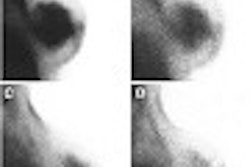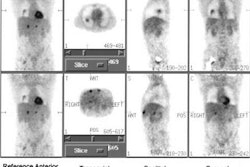LOS ANGELES - An intravascular beta probe can successfully target the vulnerable plaque that is responsible for myocardial infarction, according to a presentation Sunday at the 2002 Society of Nuclear Medicine meeting.
"Vulnerable plaque is a rupture-prone atherosclerotic plaque. Autopsy studies have shown that the majority of cases of sudden death are associated with a rupture of the underlying plaque," explained Dr. Ahmed Tawakol from Massachusetts General Hospital in Boston.
"Most ruptured plaque is associated with insignificant luminal narrow, a fairly important point in cardiology," he said.
Previous studies have looked at patients with catheterizations prior to a myocardial infarction, or after sudden death from a cardiac event, and found that in more than 60% of these cases, the underlying plaque was insignificant, less than 50%. "Not enough to raise an eyebrow in the cath lab," Tawakol said.
FDG-PET has been used to attempt to pinpoint this deceptively insignificant plaque. Vulnerable, macrophage-rich plaque contain abundant inflammatory cells, which in turn accumulate FDG. But the modality has certain limitations, such as the uptake of FDG in the myocardium, low spatial resolution, and limited mobility, he said.
Although the probe is still in the early development stages, "this intravascular beta particle detector has theoretical advantages," Tawakol said. "It overcomes the depth and mobility limitations of (PET) simply by placing the beta particle detection within the artery. The fact that myocardium-derived beta rays do not reach the intravascular capsules limits some of the additional noise. The spatial resolution improves because of the distance traveled by the beta particles, less than 2 mm."
Doctors from Memorial Sloan-Kettering Cancer Center in New York City and the University of California, Los Angeles developed the flexible probe. It is marketed by IntraMedical Imaging of Los Angeles.
For this study, the catheter-mounted scintillation detector was used on New Zealand rabbits. Atherosclerotic lesions were induced in the rabbits by balloon injury of the infradiaphragmatic aorta, followed by a high-cholesterol diet.
At 10 weeks, 1 mCi/kg FDG was administered to two rabbits with lesions and to one control rabbit. Three to four hours later, the rabbits were put down and their aortas removed as a single segment.
The thin, 1.6-mm flexible beta probe was inserted into the aorta. The probe was built by optically coupling a plastic scintillator that is 1 mm in diameter and 2 mm in length with a 40-cm-long optical fiber. It is more sensitive to positron emissions than gamma rays.
Measurements were made in triplicate at sites of grossly visible plaque, and at non-injured sites in the cholesterol-fed rabbits. Areas that corresponded in the control rabbit were imaged as well. The aortic segments were then excised and examined using standard gamma well measurements.
According to the results, the sensitivity of the probe was 850 cps/microCi. In the control aortic specimens, relatively little FDG uptake occurred in comparison to the injured atherosclerotic aortic specimens, Tawakol reported.
"Within the same rabbits, the areas of the aortas that were not injured had much less uptake compared to injured areas. This FDG uptake correlated with macrophage density in the specimens," he said.
The beta probe measurements also demonstrated differences between the plaque regions and the non-plaque regions. Catheter measurements (cps) were correlated with FDG results using standard well counter measurements (r=0.89, P<0.001). In addition, atherosclerotic plaque was easily distinguished from non-injured regions by the beta probe (11.9 cps vs. 4.8 cps in the control regions, P<0.001).
Tawakol acknowledged the study's limitations: As it was an autopsy experiment, blood-activity noise was not accounted for. Also, the catheter tip was placed directly on the plaque. In the future, for in vivo experimentation, the catheter will need to be designed to oppose the scintillator to the vessel wall directly, he said.
However, "FDG concentrates in macrophage-rich plaques, and this newly developed intravascular detector has promise for the in vivo detection of vulnerable plaques. The use of this intravascular beta particle detector may enable characterization of vulnerable plaques in human coronary arteries," he concluded.
By Shalmali PalAuntMinnie.com staff writer
June 17, 2002
Copyright © 2002 AuntMinnie.com



















